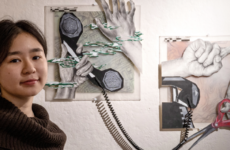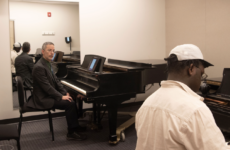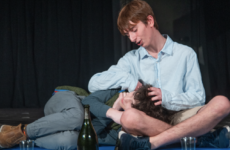At a glance, the artwork currently displayed in the PMAC gallery looks like an assortment of quilts made by the worn but nimble fingers of an aging woman. However, upon closer scrutinization, anyone can see that these quilts are not your grandmother’s thick and flowery blankets, patched together lovingly to cover innocent newborn babes. These quilts are full of color, activism, and history.
Arts Concentration’s Ellie Latham ’18 is quick to note that there is “so much more meaning behind the quilts than you can see when you look at them. You can admire them technically in their aesthetic appeal, but what each one of them means to Chawne Kimber is so important and adds so much depth and personality to the art.” Arguably, the artwork and the artist on display in the gallery could be one of the most unique that the school has hosted to date. Chawne Kimber, the artist, steeps her work full of significant meaning.
For one, her quilting is inspired by the decades-old tradition of quilt-making in her father’s family in a small Alabama town. Kimber, a mathematics professor, first turned to making quilts when hoping to earn tenure. That period of her life was stressful, and she hoped that learning to quilt would ease her mind.
As one does, Kimber picked up a bright yellow “Quilting for Dummies.” Staying up late after returning from teaching, Kimber slowly picked up the art of quilting. Her first pieces were more conventional: mostly blue and white with no words or phrases. Kimber quickly realized that she had the power to push the boundaries.
Kimber’s most recent quilts are vibrant and intricate, with all sorts of images and phrases. Two of the more eye-catching pieces on display hang side by side. The first is simpler, yet ever so striking. Two thick, brown horizontal lines run along the quilt’s top and bottom edges. A stark white middle surrounds bold, brown letters that spell “Oreo”. The quilt is meant to be more than just the image of the cookie. It’s a reference to the racial epithet that claims African-Americans can betray their race by being “white on the inside.” Kimber has experienced the term firsthand.
The quilt to the right of the “Oreo” also has a message. This quilt is populated by small colorful blocks ranging from vibrant yellows and oranges to mellow blues and greens. Throughout the piece there are also black blocks that “ground and center” the spectator. Toward the bottom of the piece, on larger blocks of various colors, eight white words have been stitched on: “In essence, I am a sophisticated cotton picker.” A quotation from Eartha Kitt, an American singer, the words are meant to both be taken lightly (Kimber uses cotton grown only in the United States to make her quilts) and soberly (Kimber can trace her roots to slavery). Similarly thought-provoking pieces on display include a self-portrait depicting a hooded Kimber, in tribute to Trayvon Martin, and a pale blue and white quilt heralding, “Stop the War on Women.”





